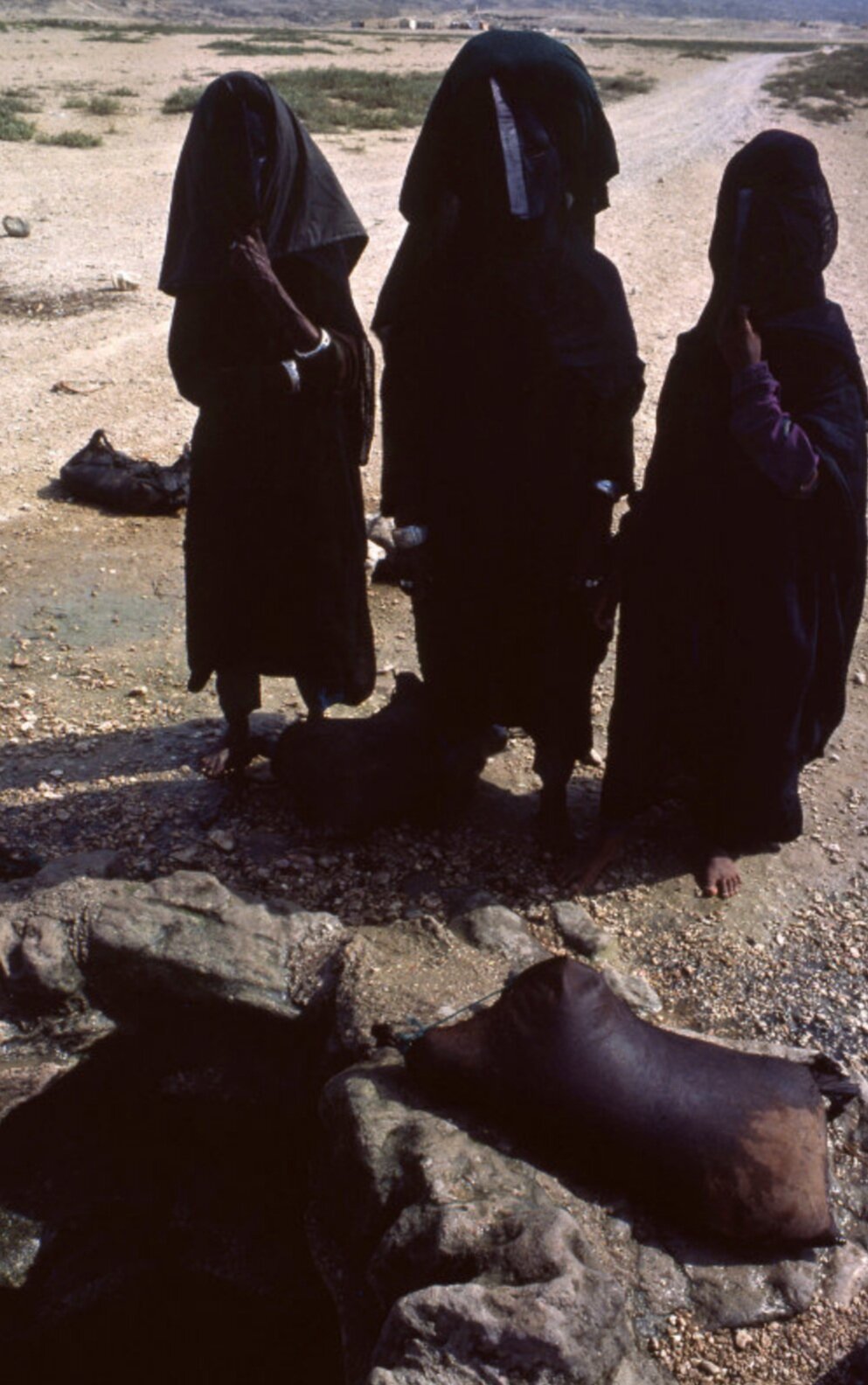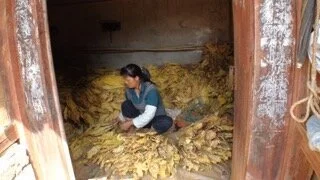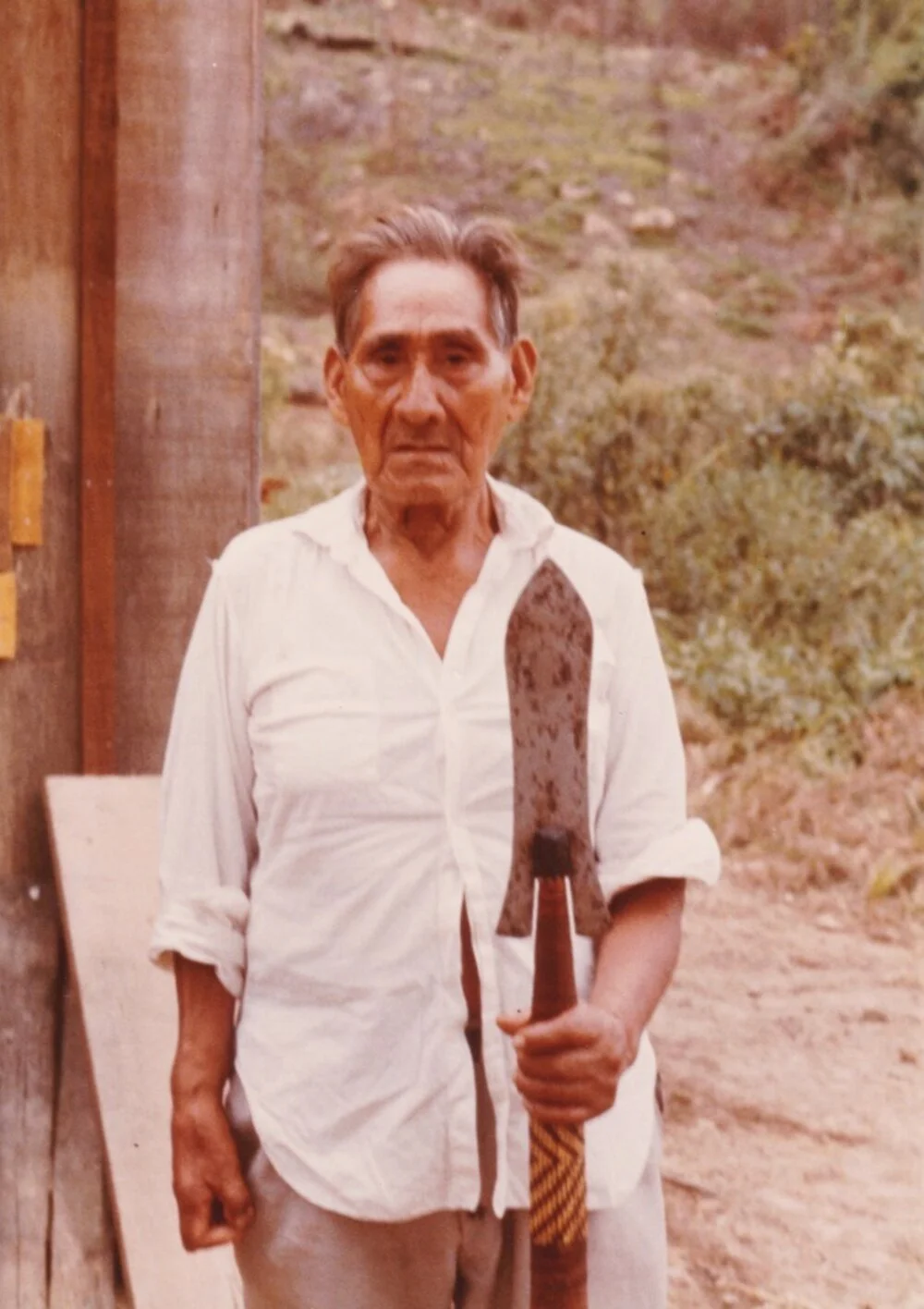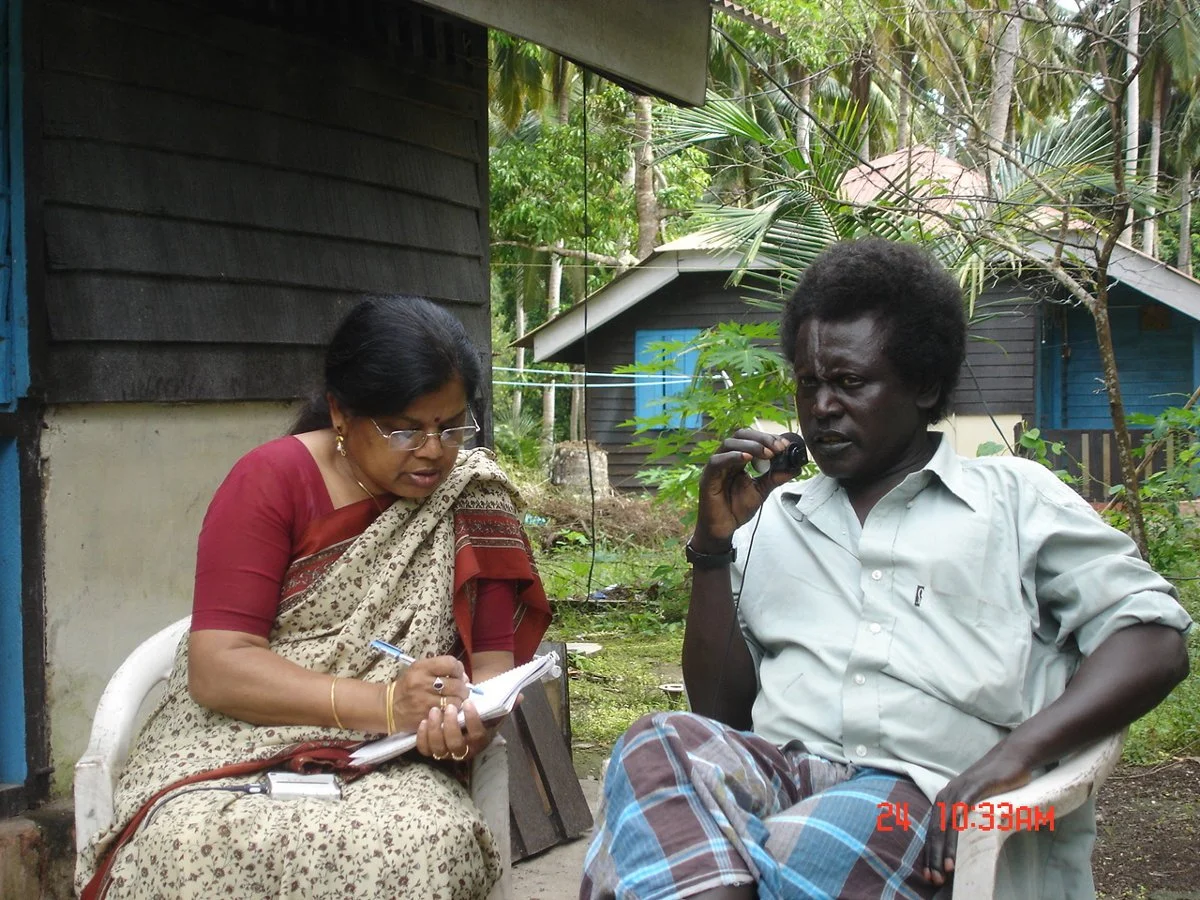STORIES
The Batāhira
February 22, 2017
Miranda Morris
University of St. Andrews
Morris: Mahmood at mouth of cave believed locally to have been used by the ‘Portugese’ as a prison
The Batāhira are a small tribe who live in the central area of the Sultanate of Oman, inhabiting the littoral opposite the Al Hallaniyyat islands (probably better known by their former name, the Kuria Muria islands), as well as a stretch of the desert escarpment above. Formerly a tribe small in number (in a tuberculosis survey I carried out in 1978, they were only some 300 people), oral tradition relates that their tribal name, “Bait Bathā” or “Bait Bathār”, comes from the word ‘baṭḥ’, ‘earth, dust’ in their language, a name, they claim, that reflects their much greater original number. Their own history says that ‘wars with the Persians and the Portuguese’ were the principal cause of this drastic drop in number, and point out the extensive burial sites and mounds which are said to be the result of these conflicts.
Before Sultan Qaboos came to power in 1970 the Batāhira were desperately poor. They were rarely stationary:, but were instead continually on the move according to season, weather, winds and the availability of fish or grazing. Their continued survival depended on their skill at harvesting the sea. From hanks of cotton yarn brought on camel back from northern Oman they twisted fishing lines and cast nets, as well as gill nets to trap shark and larger fish. The nets and lines were dyed and strengthened by steeping them in seawater with plant or shell extracts. They used stones for weights, fashioned most of their own hooks, and whittled the stems of various plants to mimic small fish for use as lures. Much fishing had to be done at night, when shark and fish come inshore to feed, and the risk of accidents on the precipitous mountain paths and cliff ledges was high, especially in some places where they had to lower themselves on home-made ropes down to the best cliff ledges for fishing. Families or groups of fishermen would set up a temporary home beneath rocks or in shallow caves above the beach, from where they could keep a close eye on the sea, watching for the dark shadows of shoaling fish or clouds of gathering gulls. Shellfish were an important component of their diet. At low tide women gathered chitons, mussels, rock oysters, abalone, limpets, sea urchins, clams, cockles and sea snails, while sea slugs, sea cucumbers, crabs, rock lobsters, octopus and squid were mainly collected by men. Fish flesh was salted and dried in the sun to preserve it, and shark livers and those of certain fish (such as the triggerfish) were rendered down to produce an oil which was used to waterproof the goatskin floats and the water-skins – the finer fish oils were also given to children as a rich food. There was no clay available locally for making clay vessels, but larger shells and turtle carapaces could be used when the few imported tin pots and bowls were not available. Fish were roasted on the embers or boiled in water, while goat and turtle flesh was usually grilled on a bed of hot stones, or a pit was dug and a layer of stones laid at the bottom on which a fire was lit. When the stones were red-hot, the carcass was lowered down and the pit covered over and left for several hours until everything was cooked through.
Morris: Mahmood and his old house in Warx
The only items the Batāhira had for barter were salted shark flesh and fins and some dried fish, with, at some seasons, salt. When the wooden trade boats sailed past their area on their seasonal trips between the Gulf and East Africa, the Batāhira would trade these products for the necessities they couldn’t make themselves: iron to make hooks and knife blades, material for clothing, a few metal pots and bowls, and dates and grain if they could afford it. The grain was usually sorghum: old men and women today still recall the very first time they tasted rice, the basic grain today. The men were skilful at hunting turtle, hooking them in the neck and playing them on long, strong lines until they had so exhausted it that it was possible to tow it ashore. In the darkest nights the strongest and bravest men crept along narrow cliff ledges to catch the plump cormorant and shearwater nestlings, considered a real treat. In the monsoon months when the sea was too stormy for fishing, the Batāhira moved further inland to the more sheltered areas at the foot of the escarpment, or down into the major dry riverbeds. At this time they harvested the small, shrivelled dates from the few wild date-palms that grew here. Strict rules governed the harvest: all goats had to be kept far from the palms, and all had to start and stop harvesting the dates at exactly the same time – no-one could start beating the palms to knock off their fruit before everyone else was there.
Morris: three masked women fetch water in a goatskin
They were too poor to own boats and swam out to their gill nets on inflated goatskins, carrying one or two extra ones with them to tie onto any shark they might have caught; this made them light enough to be dragged ashore. There were few goats, as their area lacked adequate grazing, but those they had were of incalculable value; not only did they provide rare milk and meat (young males were slaughtered soon after birth to conserve their mother’s milk) but also their skins: to make leather bags for holding water, for storing and churning milk, or to provide leather for making the cradles the women used to carry their babies on their backs, and for the vital goatskin floats for fishing. That goatskins were not always available is demonstrated by the fact that many old Batāhira remember using inflated shark stomachs for the same purpose. The first few dugout canoes began to arrive from Mukalla in the lifetime of the older members of the community, and were so uncommon that they were given personal names and treasured even more highly than a baggage camel. Food was monotonous as well as scarce, so the catching of a turtle, a dolphin, or one of the larger fish was an occasion of major celebration, with singing and dancing and women dressed up in their best. Small amounts of precious turmeric were saved for such occasions, and women would mix it with water and stain the skin of their face, neck, bosom and lower legs yellow. They would oil their hair and put on their most precious ornament, the heavy, indigo-dyed leather headdress that every married woman had. This was made from strips of leather which were plaited and woven together before being decorated with leather tassels, small discs of tin (or silver for the better off), and thick bunches of leather threads along the bottom edge. Indigo was also used to tattoo the skin and to stain the grooves cut into the surface of the top and bottom incisor teeth, and the teeth were cleaned, as throughout Oman, with a piece of root from the Salvador persica bush. A large fire was lit and the partying continued through the night.
Women had to spend much of their time walking to fetch water and carrying it home on their backs in heavy water-skins. Rare rains filled the few rock pools in the mountains; otherwise the water from the lagoons or water scrapes dug into the dry riverbeds was often brackish. The goats of an area were generally herded together, the women taking it in turns to lead them to wherever grazing could be found. They had to watch out for the wolves and leopards which were quick to take advantage of any inattention on their part, and even hyenas were known to attack the weaker goats. A woman told me of the terrible day when just in time she saw a hyena sniffing around the tripod-cradle she had laid down in the shade of an acacia while she went off in search of firewood. A lot of a woman’s time was spent trying to gather enough fuel for cooking, scouring the shore for driftwood and snapping dried twigs from the salt bush beside the sea.
Living quarters were caves, the shelter of large slabs of rock, or hollows dug among the coastal scrub. Later, rubble-walled, one-roomed, circular huts were built, roofed with dried seaweed and driftwood, and later still, with the arrival of oil companies, plywood sheets became available and simple huts were built. Clothing was limited and usually made from unbleached calico or black muslin, while women made their obligatory face masks from stiff, indigo-dyed cotton, a slice of acacia wood or a section of a gazelle horn used to keep the nose-piece rigid. Clothing was so scarce that it was not unusual for men to remove their loincloths and go into the sea naked so that they would have something dry to put one when they came out. There were no matches and people taught their children how to light a fire with flint and striker, and how to use what was locally available to make tinder to nurse the sparks into a steady flame. Knives were in short supply, and children were shown how to knap a flint to use as a blade, or how a broken bit of a glass bottle could be used instead, and which type of shark had teeth to use in place of a knife. Children made their own toys. Boys shaped stones to look like camels and goats, or made boats from pieces of wood with scraps of cloth or fibre for sails. Girls made dolls from bones or sticks, dressing them in pieces of cloth and giving them fibre hair. Different types of shell represented herds of goats and camels and their young, and livestock pens and human dwellings were made from stones and shells. Adults and children alike joined in competitive long jump and other leaping games; they played hide and seek or more energetic games which involved two teams competing to hit a homemade ball with sticks.
In the desert hinterland above, families moved with their goats and camels from acacia bush to acacia bush, setting up a temporary home beneath its thorny branches, and staying put until the grazing in the vicinity was exhausted. The Batāhira above and below helped one another: the coastal people sharing their fish when the desert was dry and unproductive, and the desert people helping with livestock products when the sea was too rough to fish. They gathered the leaflets of the desert palm, Nannhorops ritchieana, dried them in the shade, and after soaking them in soured milk, the women wove the vital milking bowls. They also made mats, baskets and containers of various sorts, while men worked the fibre to make ropes for the gill nets. In the high, dry mountains to the west, frankincense trees grew, and at times when the gum had commercial value, some Batāhira joined the work camps there to harvest the gum. Rock salt was gathered from caves high in the escarpment, and this was an important item medicinally, along with myrrh and dried aloes juice brought from Dhofar to the south. These, with a preparation made by scorching a piece of old goatskin at the fire and then pounding it to a powder, were the only medicines available to them. Otherwise most illnesses, in people and their livestock, were treated by cauterisation with red-hot irons of varying shapes.
There were special places for burying the dead, generally, beside the principal settlements. Two upright gravestones marked the grave of a man and three the grave of a woman. The dead had to be treated with respect and they were appeased by animal sacrifices made in their name, or their spirits might come back and harm the living. The older women of the Batāhira were credited with the possession of great magical powers: they were said to be able to call up winds or to stir up concealing mists; they had the power to influence the movements of fish, and could bring harm to people or their animals. Oral history tells of Bathari sorceresses playing a decisive role in the wars against the Portugese, turning the drinking water into blood and invoking gales that wrecked their ships.
They were governed by many rituals and taboos. Some tracks were forbidden to women; some coves could only be fished at night, but not if there was a moon; at certain seasons at certain beaches, only communal fishing was allowed, while at others the total catch had to be pooled and shared with widows, children and others unable to fish. Children were protected with talismans and pieces of iron repelled the forces of evil. To give an example in greater detail: the pompano fish, the main source of food in the monsoon season, was surrounded by taboos: for example, the fish may not be seen by a woman at night; instead, when she heard the low warning whistle of a man bringing this fish to her fireplace, she had to close her eyes, and she couldn’t open them again until the fish was on the fire. Again, if this fish had been gaffed, it was permitted to anyone to eat it, in the daytime hours, but if it had been caught with the bait of a baby mussel (its favourite food) then it was taboo to anybody who was not from the Batāhira. If a woman from the Batāhira was pregnant by a man from another tribe, she was not allowed to cook this fish at all until she was safely delivered of her baby. There were many other similar rulings and conventions.
Despite their harsh way of life, the Batāhira had a rich poetic culture, and when they were not hungry, spent evenings around the fire or resting in the shade at midday reciting poems, and telling the stories that gave rise to them. They would tell stories about the exploits of their ancestors, such as the hero, Ali ber Shereym, or about adventures that had happened at sea, or about men and women who had fought off wolves or braved encounters with spirits from the other world.
In the 1970s, when I first started working with the Batāhira, they were mostly undersized and thin, clothing was minimal, tuberculosis was rife, infant mortality was shockingly high and many women died in childbirth. I knew a woman who had successfully carried thirteen pregnancies to term, but not one of her children had survived to adulthood, and she remained a solitary figure. The two main settlements of Warkh and Mingiy are deserted today, and all that remains are the collapsed walls of the rubble huts, the graves, the shark storage-pits, shellfish middens and scatterings of turtle debris. Today the Batāhira are resettled in new houses in new towns, with tarmac roads, schools, hospitals, desalination plants, administrative offices, mosques, shops, street lighting and shaded sitting areas – every modern facility. There is still close interaction between the Batāhira of the upland desert and the coast, though now the journey takes minutes rather than hours.
Today only some twenty elderly men and women still speak their original language, Bathari. None of them are monolingual in Bathari, and all other members of the tribe speak Arabic alone. Bathari is seen as a low prestige language in comparison with Arabic, the language of Islam and of the Holy Qur’an, and this perhaps explains the younger generation’s eagerness to embrace Arabic and their enthusiasm for feeling themselves at last part of the wider Arabic Islamic community. One elderly woman, Sawma, reflects the views of this older Bathari-speaking generation, when she said: “The schools have removed them (i.e. the younger generation) from us; the Arabic language has removed them from us.” Certainly the younger generations used to show little interest in their former language, but today I sense a burgeoning curiosity about their language and the ways of life of the forebears. They have asked to be present at recording sessions, and have joined in the subsequent discussions with the speakers, their grandparents or great grandparents. Last year, Khalifa Hamood, a Bathari who came to work with me in St. Andrews last year, asked for some recordings of the songs of the Batāhira which I made in the 1970s to be copied onto his smartphone. On my next field trip to the area, I found that these songs had spread rapidly from phone to phone among the younger Batāhirah in Oman, and I was repeatedly passed a phone so that I could listen to them! One was particularly popular: the chant sung by the late Sa’ad Qasim to lure cormorants back from the sea to the sea cliffs.
However, it is not only the many songs and stories that will be lost to future generations when the language dies. There is also the encyclopaedic knowledge of the sea and how to wrest a living from it that is enshrined in that language: the migration patterns of different fish and shark, what they feed on and how their diet changes with the season, when they spawn, when they are fat and when lean, what winds and weathers bring them inshore or drive them out to sea, how each can be cooked and which parts are most nutritious. This loss of traditional knowledge and skills is a serious one, with implications for the future sustainability of fishing in the area. The Batāhira are already only too aware of the effects of over-fishing and pollution that is damaging the seas along their part of the coast. Nevertheless, it seems unavoidable that within a generation the language will die out. Then all that will remain will be half remembered stories, and some two and a half thousand recordings that I have made (from the late 1970s to 2016) with these skilled men and women about their earlier ways of life, which are lodged at the Endangered Languages Archive (ELAR)1 in London.
CONTINUE READING STORIES


















